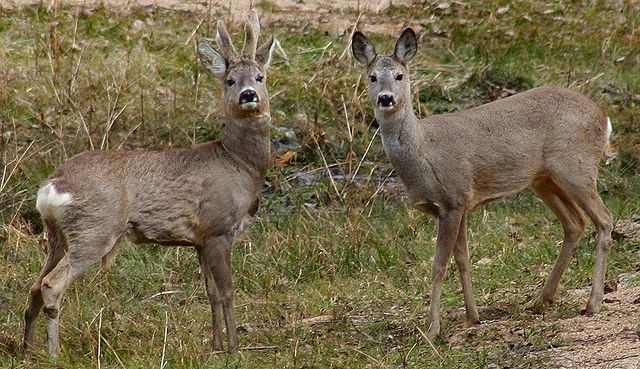Top Qs
Timeline
Chat
Perspective
List of mammals of Monaco
From Wikipedia, the free encyclopedia
Remove ads
This is a list of the mammal species recorded in Monaco. There are ten mammal species in Monaco, none of which are threatened.[1]
The following tags are used to highlight each species' conservation status as assessed by the International Union for Conservation of Nature:
| EX | Extinct | No reasonable doubt that the last individual has died. |
| EW | Extinct in the wild | Known only to survive in captivity or as a naturalized populations well outside its previous range. |
| CR | Critically endangered | The species is in imminent risk of extinction in the wild. |
| EN | Endangered | The species is facing an extremely high risk of extinction in the wild. |
| VU | Vulnerable | The species is facing a high risk of extinction in the wild. |
| NT | Near threatened | The species does not meet any of the criteria that would categorise it as risking extinction but it is likely to do so in the future. |
| LC | Least concern | There are no current identifiable risks to the species. |
| DD | Data deficient | There is inadequate information to make an assessment of the risks to this species. |
Remove ads
Order: Rodentia (rodents)
Rodents make up the largest order of mammals, with over 40% of mammalian species. They have two incisors in the upper and lower jaw which grow continually and must be kept short by gnawing. Most rodents are small though the capybara can weigh up to 45 kg (99 lb).
- Suborder: Myomorpha
- Family: Muridae (mice, rats, gerbils, etc.)
- Subfamily: Murinae
- Genus: Apodemus
- Wood mouse, A. sylvaticus LC
- Genus: Apodemus
- Subfamily: Murinae
- Family: Muridae (mice, rats, gerbils, etc.)
Remove ads
Order: Erinaceomorpha (hedgehogs and gymnures)

The order Erinaceomorpha contains a single family, Erinaceidae, which comprise the hedgehogs and gymnures. The hedgehogs are easily recognised by their spines while gymnures look more like large rats.
- Family: Erinaceidae (hedgehogs)
- Subfamily: Erinaceinae
- Genus: Erinaceus
- West European hedgehog, E. europaeus LC[2]
- Genus: Erinaceus
- Subfamily: Erinaceinae
Order: Soricomorpha (shrews, moles, and solenodons)

The "shrew-forms" are insectivorous mammals. The shrews and solenodons closely resemble mice while the moles are stout-bodied burrowers.
- Family: Talpidae (moles)
- Subfamily: Talpinae
- Tribe: Talpini
- Genus: Talpa
- Mediterranean mole, Talpa caeca
- European mole, Talpa europaea
- Genus: Talpa
- Tribe: Talpini
- Subfamily: Talpinae
Order: Cetacea (whales)
The order Cetacea includes whales, dolphins and porpoises. They are the mammals most fully adapted to aquatic life with a spindle-shaped nearly hairless body, protected by a thick layer of blubber, and forelimbs and tail modified to provide propulsion underwater.
- Suborder: Mysticeti
- Family: Balaenopteridae
- Genus: Balaenoptera
- Fin whale, Balaenoptera physalus EN
- Genus: Balaenoptera
- Family: Balaenopteridae
- Suborder: Odontoceti
- Superfamily: Platanistoidea
- Family: Delphinidae (marine dolphins)
- Genus: Stenella
- Striped dolphin, Stenella coeruleoalba LC
- Genus: Delphinus
- Common dolphin, Delphinus delphis LC
- Genus: Stenella
- Family: Delphinidae (marine dolphins)
- Superfamily: Platanistoidea
Remove ads
Order: Carnivora (carnivorans)

There are over 260 species of carnivorans, the majority of which feed primarily on meat. They have a characteristic skull shape and dentition.
- Suborder: Caniformia
- Family: Canidae (dogs, foxes)
- Family: Mustelidae (mustelids)
- Genus: Mustela
- Least weasel, M. nivalis LC[4]
- Genus: Mustela
Order: Artiodactyla (even-toed ungulates)

The even-toed ungulates are ungulates whose weight is borne about equally by the third and fourth toes, rather than mostly or entirely by the third as in perissodactyls. There are about 220 artiodactyl species, including many that are of great economic importance to humans.
- Family: Cervidae (deer)
- Subfamily: Capreolinae
Locally extinct
The following species are locally extinct in the country:
- Brown bear, Ursus arctos[5]
See also
Notes
References
Wikiwand - on
Seamless Wikipedia browsing. On steroids.
Remove ads